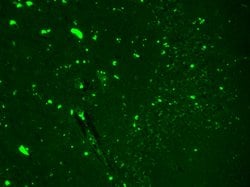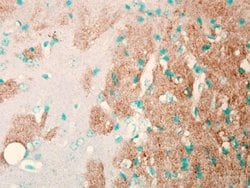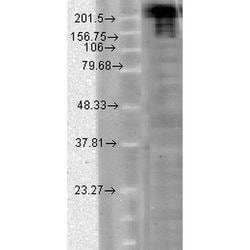Learn More
Invitrogen™ SCN9A Monoclonal Antibody (N68/6)
Mouse Monoclonal Antibody
Supplier: Invitrogen™ MA527664
Description
1 μg/mL of MA5-27664 was sufficient for detection of Nav1.7 in 10 μg of HEK-293 cell lysate transiently expressing Nav1.7 by colorimetric immunoblot analysis using Goat anti-mouse IgG:HRP as the secondary antibody. Detects approximately 230kDa. No cross-reactivity against other Nav channels.
Epithelial sodium channels are amiloride-sensitive members of the Degenerin/epithelial sodium channel (Deg/ENaC) superfamily of ion channels. Members of this superfamily of ion channels share organizational similarity in that they all possess two short intracellular amino and carboxyl termini, two short membrane spanning segments, and a large extracellular loop with a conserved cysteine-rich region. There are three homologous isoforms of the ENaC (alpha, beta, and gamma) protein. ENaC in the kidney, lung, and colon plays an essential role in trans-epithelial sodium and fluid balance. ENaC also mediates aldosterone-dependent sodium reabsorption in the distal nephron of the kidney, thus regulating blood pressure. ENaC is thought to be regulated, in part, through association with the cystic fibrosis transmembrane conductance regulator (CFTR) chloride ion channel. Gain-of-function mutations in beta- or gamma-ENaC can cause severe arterial hypertension (Liddels syndrome) and loss-of-function mutations in alpha- or beta-ENaC causes pseudohypoaldosteronism (PHA-1).
Specifications
| SCN9A | |
| Monoclonal | |
| 1 mg/mL | |
| PBS with 50% glycerol and 0.09% sodium azide; pH 7.4 | |
| O08562, Q15858, Q62205 | |
| SCN9A | |
| Fusion protein amino acids 1751-1946 (C-terminus) of human Nav1.7. | |
| 100 μg | |
| Primary | |
| Human, Mouse, Rat, Hamster | |
| Antibody | |
| IgG1 |
| Immunohistochemistry (Frozen), Immunohistochemistry (Paraffin), Immunoprecipitation, Western Blot, Immunocytochemistry, Microarray | |
| N68/6 | |
| Unconjugated | |
| SCN9A | |
| ETHA; FEB3B; GEFSP7; hNaN; hNE Na; hNE-Na; HSAN2D; KIAA1356; Kiaa4197; MED; mKIAA4197; NAC1; NAC2; NAC3; Nav1.1; Nav1.2; Nav1.3; Nav1.4; Nav1.5; Nav1.6; Nav1.7; Nav1.8; Nav1.9; NE; NE NA; NENA; NE-NA; neuroendocrine sodium channel; Peripheral sodium channel 1; PN1; SCN1; SCN10A; SCN11A; SCN12A; SCN1A; Scn2a; SCN2A1; SCN2A2; SCN3A; SCN4A; SCN5A; SCN8A; Scn9a; SFNP; SNS2; sodium channel 25; sodium channel protein type 9 subunit alpha; Sodium channel protein type IX subunit alpha; sodium channel, voltage gated, type IX alpha subunit; sodium channel, voltage-gated, type 9, alpha polypeptide; sodium channel, voltage-gated, type IX, alpha; sodium channel, voltage-gated, type IX, alpha polypeptide; sodium channel, voltage-gated, type IX, alpha subunit; sodium voltage-gated channel alpha subunit 9; voltage-gated sodium channel alpha subunit Nav1.7; voltage-gated sodium channel subunit alpha Nav1.7 | |
| Mouse | |
| Protein G | |
| RUO | |
| 100751370, 20274, 6335, 78956 | |
| -20°C | |
| Liquid |
Your input is important to us. Please complete this form to provide feedback related to the content on this product.


